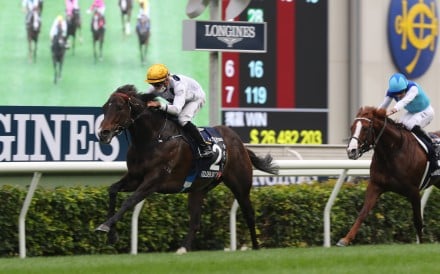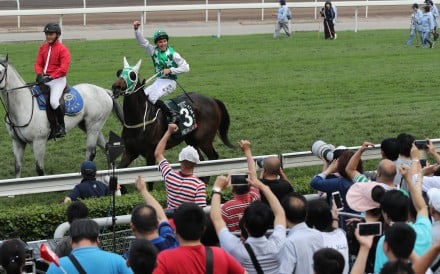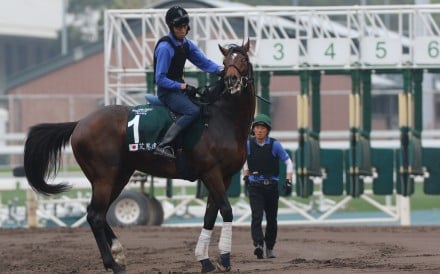Well may you snigger at John Moore’s collection of safari suits, but he might be on to something, and the eccentric trainer is certainly the one having the last laugh as we swelter in stifling heat.
Seriously, it’s time to reconsider racing in the hottest and most humid month of the year – a point graphically illustrated by the fact that Moore might be the most suitably dressed person, save for a few flip-flop- and tank top-wearing punters in the outer reaches.
Over the past decade as more than 100 races have been added to the calendar, the season has stretched ever further into summer. Ten years ago, the season finished on the second or third Sunday in June, and we were all on a beach by now.
The season finale was then shifted to late June or Wednesday’s corresponding July 1 public holiday fixture. Five years ago the club made the leap into mid July – Hong Kong’s hottest month on average. We still have two more Sundays at Sha Tin to go after Wednesday, and few are looking forward to it unless an AC is your companion.
Let’s be clear that this isn’t an animal welfare issue – the Jockey Club goes to great lengths to ensure horses are kept safe and “warm weather protocols” are in place.
 It’s not just about heat, but the stifling humidity. A wet bulb globe reading is used to measure the comfort level, if you like, creating a figure based not only on temperature, but moisture, direct sunlight and even the effect of breeze, something usually non-existent at Sha Tin unless there is a storm approaching. The wet bulb reading is used as a measure by most outdoor sporting organisations to assess safety levels for competitors.
It’s not just about heat, but the stifling humidity. A wet bulb globe reading is used to measure the comfort level, if you like, creating a figure based not only on temperature, but moisture, direct sunlight and even the effect of breeze, something usually non-existent at Sha Tin unless there is a storm approaching. The wet bulb reading is used as a measure by most outdoor sporting organisations to assess safety levels for competitors.
Once the reading climbs above a certain level, or even threatens to, warm weather protocols are put in place by the Jockey Club. Even jubilant winning owners are forced to forgo precious photo opportunities in front of the exposed grandstand.
There are already high-powered fans behind the starting barriers, misting fans and extra hoses in the undercover unsaddling area and horses do not parade for as long in extreme conditions.
For the punters in front of the public stand on Sunday there were even portable air-conditioning units out in the open – but a quick test of those revealed them to be about as useful as a pogo stick in quicksand. The units were working so hard it was more likely they would contribute to global warming than cooling anyone off.
 Why go to all of that trouble when there is a simple solution? Race later in the day or at night.
Why go to all of that trouble when there is a simple solution? Race later in the day or at night.
There is the option of twilight meetings, whatever happened to those? The final race on Saturday was held in perfect conditions – the sting had gone out of the air at 5.45pm and there was even a gentle breeze blowing.
To our surprise, the temperature hadn’t dropped much at all. It was still hovering around 32 degrees Celsius, but there was less direct sunlight.
The temperature does usually begin to drop considerably at 5pm and that’s when the races should be starting, not finishing (According to the Hong Kong Observatory, Saturday’s maximum temperature was 33.4 degrees, a reading taken from a weather station in the racecourse trotting ring).
 Of course, horses “handle” the conditions – they are tough, acclimatised athletes, even if they usually don’t train in temperatures anywhere near what they would face between 2pm and 4pm on a baking July day, but is it necessary and the most suitable time to race?
Of course, horses “handle” the conditions – they are tough, acclimatised athletes, even if they usually don’t train in temperatures anywhere near what they would face between 2pm and 4pm on a baking July day, but is it necessary and the most suitable time to race?
And jockeys must suffer terribly in the conditions. Already dehydrated due to wasting, they are in a vulnerable, weakened state, and then asked to push themselves to the limit and remain safe while they are at it.
Out on the turf, it must be particularity steamy on a track that is watered on race morning and losing moisture into the atmosphere at a rapid rate. Spare a thought for the barrier attendants too, who are doing a difficult and dangerous job that requires concentration to ensure the safety of everyone involved.So why not race into the evening? The only reason we can think of is the driving factor behind most decisions regarding race programming: betting turnover.
The Jockey Club’s customers are of course creatures of habit, and we wouldn’t want them arriving at an empty, air-conditioned betting shop during the middle of the day with noting to do, would we?
A cynic might point out that there are no soccer games to bet on during the day time – and if there were, the club would have less issue with pushing it’s starting times back.
Of course, there is one other solution, albeit extreme: we could all start wearing safari suits to Sha Tin, and no one wants to see that.
















